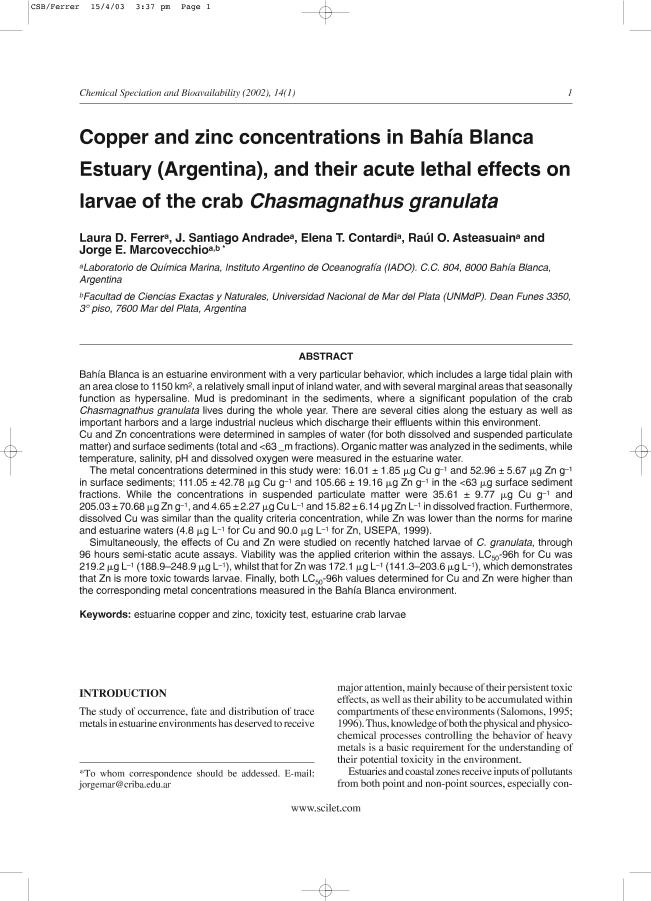Artículo
Copper and zinc concentrations in Bahía Blanca estuary (Argentina), and their acute lethal effects on larvae of the crab Chasmagnathus granulata
Ferrer, Laura Daniela; Andrade, Santiago; Contardi, Elena Teresa ; Asteasuain, Raul Oscar
; Asteasuain, Raul Oscar ; Marcovecchio, Jorge Eduardo
; Marcovecchio, Jorge Eduardo
 ; Asteasuain, Raul Oscar
; Asteasuain, Raul Oscar ; Marcovecchio, Jorge Eduardo
; Marcovecchio, Jorge Eduardo
Fecha de publicación:
10/2002
Editorial:
Taylor & Francis
Revista:
Chemical Speciation And Bioavailability
ISSN:
0954-2299
e-ISSN:
2047-6523
Idioma:
Inglés
Tipo de recurso:
Artículo publicado
Clasificación temática:
Resumen
Bahía Blanca is an estuarine environment with a very particular behavior, which includes a large tidal plain with an area close to 1150 km2, a relatively small input of inland water, and with several marginal areas that seasonally function as hypersaline. Mud is predominant in the sediments, where a significant population of the crab Chasmagnathus granulata lives during the whole year. There are several cities along the estuary as well as important harbors and a large industrial nucleus which discharge their effluents within this environment. Cu and Zn concentrations were determined in samples of water (for both dissolved and suspended particulate matter) and surface sediments (total and <63 _m fractions). Organic matter was analyzed in the sediments, while temperature, salinity, pH and dissolved oxygen were measured in the estuarine water. The metal concentrations determined in this study were: 16.01 ± 1.85 g Cu g–1 and 52.96 ± 5.67 g Zn g–1 in surface sediments; 111.05 ± 42.78 g Cu g–1 and 105.66 ± 19.16 g Zn g–1 in the <63 g surface sediment fractions. While the concentrations in suspended particulate matter were 35.61 ± 9.77 g Cu g–1 and 205.03 ± 70.68 g Zn g–1, and 4.65 ± 2.27 g Cu L–1 and 15.82 ± 6.14 μg Zn L–1 in dissolved fraction. Furthermore, dissolved Cu was similar than the quality criteria concentration, while Zn was lower than the norms for marine and estuarine waters (4.8 g L–1 for Cu and 90.0 g L–1 for Zn, USEPA, 1999). Simultaneously, the effects of Cu and Zn were studied on recently hatched larvae of C. granulata, through 96 hours semi-static acute assays. Viability was the applied criterion within the assays. LC50-96h for Cu was 219.2 g L–1 (188.9–248.9 g L–1), whilst that for Zn was 172.1 g L–1 (141.3–203.6 g L–1), which demonstrates that Zn is more toxic towards larvae. Finally, both LC50-96h values determined for Cu and Zn were higher than the corresponding metal concentrations measured in the Bahía Blanca environment.
Palabras clave:
Estuario de Bahia Blanca
,
Metales Traza
,
Bioindicador
,
Cangrejo Cavador
Archivos asociados
Licencia
Identificadores
Colecciones
Articulos(IADO)
Articulos de INST.ARG.DE OCEANOGRAFIA (I)
Articulos de INST.ARG.DE OCEANOGRAFIA (I)
Citación
Ferrer, Laura Daniela; Andrade, Santiago; Contardi, Elena Teresa; Asteasuain, Raul Oscar; Marcovecchio, Jorge Eduardo; Copper and zinc concentrations in Bahía Blanca estuary (Argentina), and their acute lethal effects on larvae of the crab Chasmagnathus granulata; Taylor & Francis; Chemical Speciation And Bioavailability; 15; 1; 10-2002; 7-14
Compartir
Altmétricas



